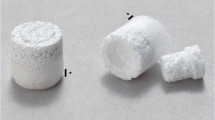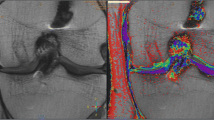Abstract
Purpose
To demonstrate that iliac crest cartilage may be used to repair articular cartilage defects in the knees of rabbits.
Methods
Full-thickness cartilage defects were created in the medial femoral condyle on both knees of 36 New Zealand white rabbits. The 72 defects were randomly assigned to be repaired with ipsilateral iliac crest cartilage (Group I), osteochondral tissues removed at defect creation (Group II), or no treatment (negative control, Group III). Animals were killed at 6, 12, and 24 weeks post-operatively. The repaired tissues were harvested for magnetic resonance imaging (MRI), histological studies (haematoxylin and eosin and immunohistochemical staining), and mechanical testing.
Results
At 6 weeks, the iliac crest cartilage graft was not yet well integrated with the surrounding articular cartilage, but at 12 weeks, the graft deep zone had partial ossification. By 24 weeks, the hyaline cartilage-like tissue was completely integrated with the surrounding articular cartilage. Osteochondral autografts showed more rapid healing than Group I at 6 weeks and complete healing at 12 weeks. Untreated defects were concave or partly filled with fibrous tissue throughout the study. MRI showed that Group I had slower integration with surrounding normal cartilage compared with Group II. The mechanical properties of Group I were significantly lower than those of Group II at 12 weeks, but this difference was not significant at 24 weeks.
Conclusion
Iliac crest cartilage autografts were able to repair knee cartilage defects with hyaline cartilage and showed comparable results with osteochondral autografts in the rabbit model.






Similar content being viewed by others
References
Baums MH, Heidrich G, Schultz W, Steckel H, Kahl E, Klinger HM (2006) Autologous chondrocyte transplantation for treating cartilage defects of the talus. J Bone Jt Surg Am 88:303–308
Benum P (1975) Autogenous transplantation of apophyseal cartilage to osteochondral defects of joints. Acta Orthop Scand 46:11–24
Bougault C, Paumier A, Aubert-Foucher E, Mallein-Gerin F (2009) Investigating conversion of mechanical force into biochemical signaling in three-dimensional chondrocyte cultures. Nat Protoc 4:928–938
Chen H, Yang X, Liao Y, Zeng X, Liang P, Kang N, Tan J, Liang Z (2011) Mri and histologic analysis of collagen type ii sponge on repairing the cartilage defects of rabbit knee joints. J Biomed Mater Res B Appl Biomater 96:267–275
Chen H, Sun J, Hoemann CD, Lascau-Coman V, Ouyang W, McKee MD, Shive MS, Buschmann MD (2009) Drilling and microfracture lead to different bone structure and necrosis during bone-marrow stimulation for cartilage repair. J Orthop Res 27:1432–1438
Chuckpaiwong B, Berkson EM, Theodore GH (2008) Microfracture for osteochondral lesions of the ankle: outcome analysis and outcome predictors of 105 cases. Arthroscopy 24:106–112
Ehlers TW, Vogel KG (1998) Proteoglycan synthesis by fibroblasts from different regions of bovine tendon cultured in alginate beads. Comp Biochem Physiol A MolIntegr Physiol 121:355–363
Guilak F, Ratcliffe A, Mow VC (1995) Chondrocyte deformation and local tissue strain in articular cartilage: a confocal microscopy study. J Orthop Res 13:410–421
Hsieh CH, Lin YH, Lin S, Tsai-Wu JJ, Herbert WC, Jiang CC (2008) Surface ultrastructure and mechanical property of human chondrocyte revealed by atomic force microscopy. Osteoarthr Cartil 16:480–488
Jiang Y, Chen LK, Zhu DC, Zhang GR, Guo C, Qi YY, Ouyang HW (2010) The inductive effect of bone morphogenetic protein-4 on chondral lineage differentiation and in situ cartilage repair. Tissue Eng Part A 16:1621–1632
Jin LH, Choi BH, Kim YJ, Park SR, Jin CZ, Min BH (2011) Implantation of bone marrow-derived buffy coat can supplement bone marrow stimulation for articular cartilage repair. Osteoarthr Cartil 19:1440–1448
Jing LZ, Hu YL, Guo QW (2012) Histological characteristics of iliac crest cartilage in rabbits with different ages. Chin J Sports Med 31:124–128
Kandel RA, Grynpas M, Pilliar R, Lee J, Wang J, Waldman S, Zalzal P, Hurtig M (2006) Repair of osteochondral defects with biphasic cartilage-calcium polyphosphate constructs in a sheep model. Biomaterials 27:4120–4131
Kim M, Foo LF, Uggen C, Lyman S, Ryaby JT, Moynihan DP, Grande DA, Potter HG, Pleshko N (2010) Evaluation of early osteochondral defect repair in a rabbit model utilizing Fourier transform-infrared imaging spectroscopy, magnetic resonance imaging, and quantitative T2 mapping. Tissue Eng Part C Methods 16:355–364
Kreuz PC, Steinwachs M, Erggelet C, Lahm A, Henle P, Niemeyer P (2006) Mosaicplasty with autogenous talar autograft for osteochondral lesions of the talus after failed primary arthroscopic management: a prospective study with a 4-year follow-up. Am J Sports Med 34:55–63
Lin L, Zhou C, Wei X, Hou Y, Zhao L, Fu X, Zhang J, Yu C (2008) Articular cartilage repair using dedifferentiated articular chondrocytes and bone morphogenetic protein 4 in a rabbit model of articular cartilage defects. Arthr Rheum 58:1067–1075
Osman A (2008) The treatment of osteochondral defects with autologous osteochondral and apophyseal grafts in animal models. Jt Dis Rel Surg 19:119–126
Pinney JR, Taylor C, Doan R, Burghardt AJ, Li X, Kim HT, Benjamin MC, Majumdar S (2012) Imaging longitudinal changes in articular cartilage and bone following doxycycline treatment in a rabbit anterior cruciate ligament transection model of osteoarthritis. Magn Reson Imaging 30:271–282
Pombo-Suarez M, Castano-Oreja MT, Calaza M, Gomez-Reino J, Gonzalez A (2009) Differential upregulation of the three transforming growth factor beta isoforms in human osteoarthritic cartilage. Ann Rheum Dis 68:568–571
Ponseti IV, Pedrini-Mille A, Pedrini V (1968) Histological and chemical analysis of human iliac crest cartilage. I. Observations on trunk growth. Calcif Tissue Res 2:197–213
Potter K, Butler JJ, Horton WE, Spencer RG (2000) Response of engineered cartilage tissue to biochemical agents as studied by proton magnetic resonance microscopy. Arthr Rheum 43:1580–1590
Roberts S, McCall IW, Darby AJ, Menage J, Evans H, Harrison PE, Richardson JB (2003) Autologous chondrocyte implantation for cartilage repair: monitoring its success by magnetic resonance imaging and histology. Arthr Res Ther 5:60–73
Saldanha KJ, Doan RP, Ainslie KM, Desai TA, Majumdar S (2011) Micrometer-sized iron oxide particle labeling of mesenchymal stem cells for magnetic resonance imaging-based monitoring of cartilage tissue engineering. Magn Reson Imaging 29:40–49
Scranton PJ, Frey CC, Feder KS (2006) Outcome of osteochondral autograft transplantation for type-V cystic osteochondral lesions of the talus. J Bone Jt Surg Br 88:614–619
Szeparowicz P, Popko J, Sawicki B, Wolczynski S (2006) Is the repair of articular cartilage lesion by costal chondrocyte transplantation donor age-dependent? An experimental study in rabbits. Folia Histochem Cytobiol 44:201–206
Wakitani S, Goto T, Pineda SJ, Young RG, Mansour JM, Caplan AI (1994) Mesenchymal cell-based repair of large, full-thickness defects of articular cartilage. J Bone Jt Surg Am 76-A:579–592
Acknowledgments
The authors thank Qingyuan He for assisting with the MRI examination.
Conflict of interest
All authors declare that they have no conflict of interest.
Author information
Authors and Affiliations
Corresponding authors
Rights and permissions
About this article
Cite this article
Jing, L., Zhang, J., Leng, H. et al. Repair of articular cartilage defects in the knee with autologous iliac crest cartilage in a rabbit model. Knee Surg Sports Traumatol Arthrosc 23, 1119–1127 (2015). https://doi.org/10.1007/s00167-014-2906-8
Received:
Accepted:
Published:
Issue Date:
DOI: https://doi.org/10.1007/s00167-014-2906-8




